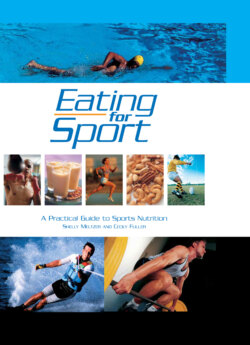Читать книгу Eating for Sport - Shelly Meltzer - Страница 24
MANIPULATING THE FUEL MIX – HOW TO BECOME A BETTER FAT BURNER
ОглавлениеRecent evidence shows that by manipulating training and diet you can alter the storage of carbohydrate and fat as well as their contribution to the fuel mix. Therefore, with an understanding of foods (the nutrients and fuel they provide) and the specific demands of particular sports, you can decrease one of the key factors causing fatigue and so optimize performance.
There are many anecdotal reports that athletes participating in different sporting events eat quite differently, instinctively selecting a diet to maximize their endurance. Many ultra-endurance athletes have been using high-fat diets. Documented dietary intakes in successful Antarctic crossings have been 57% fat, 34.6% carbohydrate and 8.4% protein of total energy intake. Mark Allen, six-times winner of the Hawaiian Ironman Triathlon (3.9km/2.4-mile swim, 180km/112-mile cycle, 42.2km/26-mile run) has said that he does not do well on a high-carbohydrate diet. ‘It seemed like it was too low in protein and I personally needed a little more fat … so I didn’t really tell people how I ate because it was so contrary to what was popular in the ’80s.’ Similarly, Paula Newby Fraser, eight-times winner of the women’s Hawaiian Ironman Triathlon, admitted to not doing well on a traditional high-carbohydrate diet and has been quoted as saying: ‘You can’t train for the Ironman on pasta and salads.’
In support of these practices, sport scientists at the University of Cape Town have calculated that to complete the marathon (after having swum and cycled) in a time of 2hr 40min instead of 3hr 30min would require an additional 14.4kJ/min (60.5kcal/min). Because at this stage of the ultra-endurance event the energy from the body’s own supplies of carbohydrate is depleted and exogenous carbohydrate (dietary carbohydrate provided by food/drink) cannot make up the difference, the only solution would be to increase the body’s capacity to burn fat by 0.39g/min.
By manipulating your training and dietary regimes you can get your muscle to adapt to use more fat. Specific training causes several favourable changes in the energy systems you use. Firstly, your muscle is able to store more glycogen (double compared to an untrained athlete) and training also allows the liver to make more glycogen from lactate. Secondly, training also increases the capacity of the mitochondria to burn more fat (as a result of metabolic changes such as an increase in enzymes that are involved in fatty acid transportation and oxidation), as well as hormonal changes in plasma insulin and glucagon, which reduces fat storage.
Dietary manipulation is probably the most potent intervention that alters your capacity to burn more fat and so spare carbohydrate. The point at which fat and carbohydrate oxidation are equal (at a specific exercise intensity) is referred to as the cross-over (see graph p29). This can be shifted with dietary manipulation and training. Studies have shown that by increasing dietary fat to 70% of total energy intake (fat-loading) for about five days prior to prolonged exercise, the reliance on carbohydrate is decreased. This high-fat regime should be followed by a high-carbohydrate diet for one to three days. In this time the body is able to retool the mitochondria and adapt enzymes and hormones to burn fat, thereby slowing the rate of carbohydrate burning. For maximum benefit, the fat needs to be saturated (the less healthy animal fats) to create insulin resistance. Therefore, fat-loading can improve the mobilization of intra-muscular fat stores and limit glucose oxidation, which allows for prolonged exercise. (See fat-loading tips p166). However, there may be an increased perception of effort, so that this technique will not necessarily improve performance.
Many dietary supplements are marketed on the premise that they can change your ability to burn fat or carbohydrate. Caffeine, Medium-Chain Triglycerides (MCT), l-carnitine have all been promoted as so-called fat-burners. However, there is currently little evidence to support these effects and even in the case of caffeine, it loses its ability to mobilize fat in athletes who have carbohydrate-loaded (see p100).
Training and competing in ultra-endurance events needs specific dietary manipulation to meet the energy requirement, while taking practical considerations into account.
